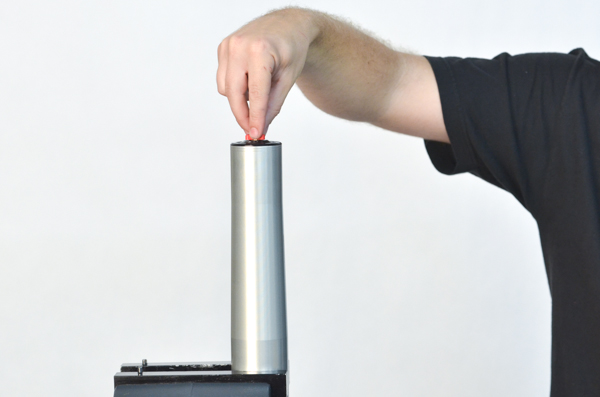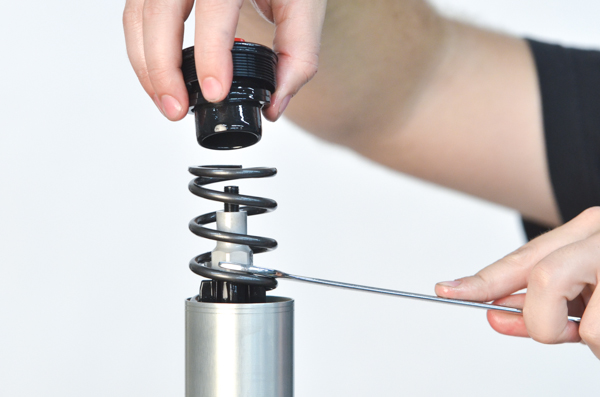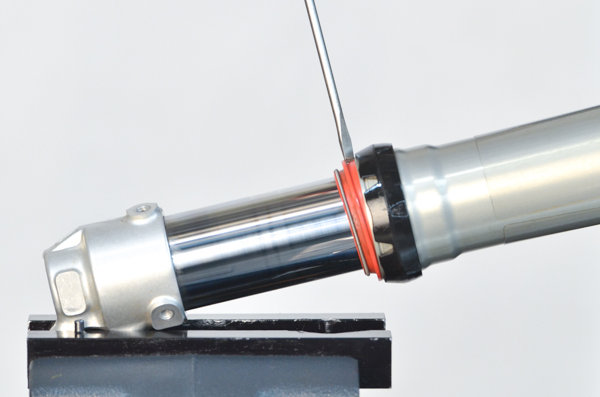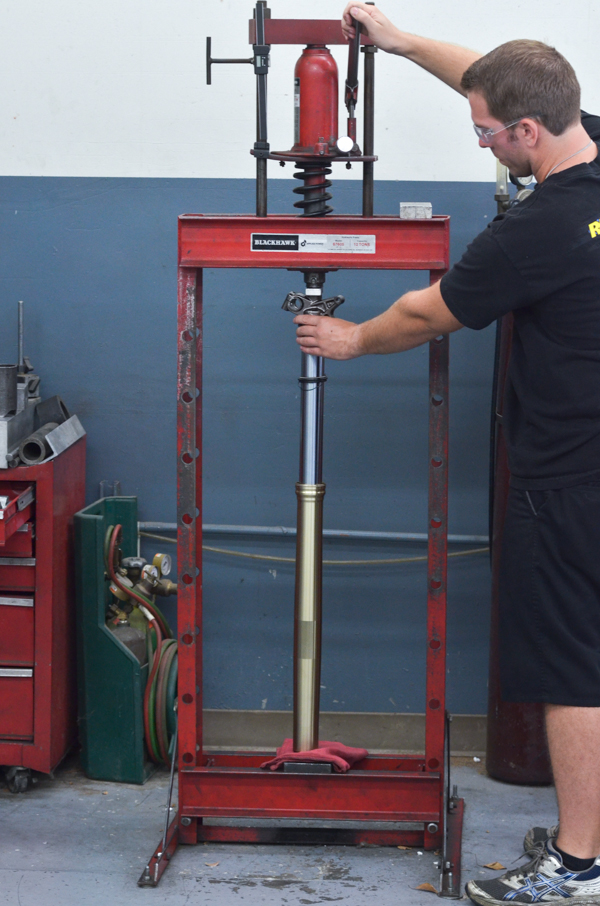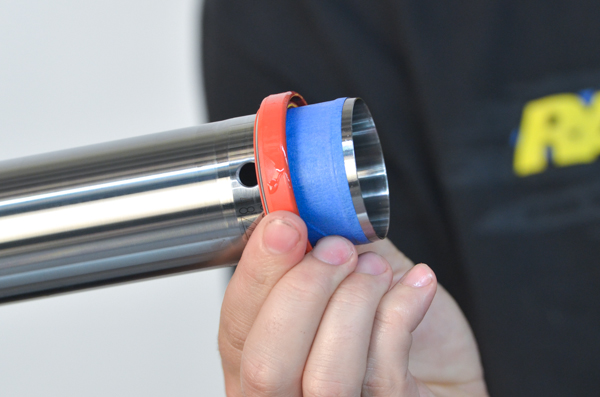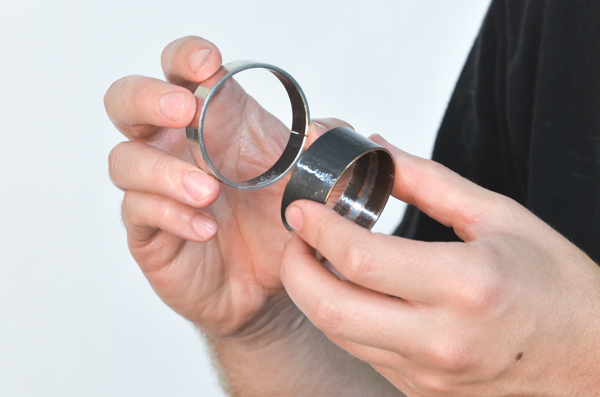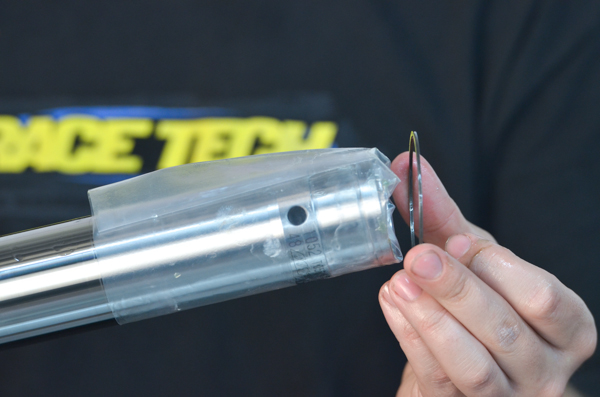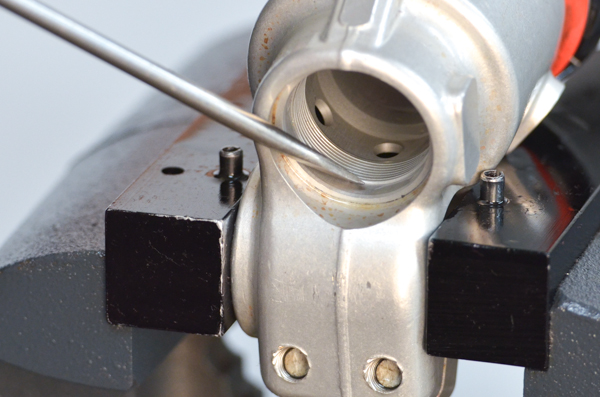WP 4CS FORK REBUILD | |
D2- Loosen the fork cap with a pin spanner (shown). We have a really cool Fork Cap/Comp Assembly Tool (TFCW PS36048) available. | |
D3- Use the pin spanner or fork cap wrench and a 19mm wrench to remove the cap from the damping rod. | |
D4- Remove the cap. | |
D5- Remove the spring from the fork tube. | |
D6- Pour out the oil and dispose of properly. | |
D7- Clamp the fork bottom in a vise. Loosen the compression valve assembly using a 22mm Allen or TFCW PS3648. Note - Again this is the TFCW PS3648 using the other end (cool huh?) DO NOT USE AN IMPACT WRENCH! LOOSEN BY HAND. | |
D8- Remove the compression valve assembly from the bottom of the fork. Pour out the oil and dispose of properly. | |
D11- Pull the cartridge from the fork tubes. | |
D12- If you are splitting the tubes for seal and bushing mantenance gently remove the dust seal with a thin flat head screwdriver. | |
D13- Remove the seal retainer clip with a Clip Tool (TSCP 01). | |
D14- Slide hammer the fork seal and bushings out forcefully. | |
D15- Tip: You may need to heat the seal/bushing area if the tubes don't come apart easily during slide hammering. Try slide hammering after heating this area. Use gloves. | |
D16- Some forks may suffer damage to the Teflon bushings during disassembly (as shown). Its good to have replacement bushings on hand, just in case. | |
D17- Tip - Another way to remove the seal with a minimal chance of damage to the bushing is to completely fill the fork with used oil, invert it, remove the wiper and clip, and put it into hydraulic press to force the seal out. This seems like it could be a big mess but if the fork is completely full and there is no compressible air space, the seal pushes out and a small amount dribbles over the edge. Once the seal is out it is usually much easier to get the bushing out. Heat still helps. | |
D18- Remove the inner fork bushing by opening up the bushing using your fingernails inserted into the gap. If the bushing is too stiff for your little girly hands, gently use a screwdriver. | |
D19- If you're not replacing seals, use blue masking tape (or electrical tape) to cover the sharp edge of the bushing groove during removal. Note - In most cases we recommend replacing the seals. Replace both the oil and dust seal together. Use only original WP parts. | |
D20- Inspect the fork tube for pits, dings, and straightness. Come on AJ, take a closer look! | |
D21- Inspect the bushings for damage, including worn Teflon or embedded material. Teflon is a registered trademark of Dupont Corp. If there is embedded material make sure you figure out where it came from so it doesn't happen again! | |
D22- Remove the adjuster rod from the center of the damping rods. | |
D23- Unscrew the jam nut and spring guide and remove it from the rebound rod. | |
D25- Pack the thread with heavy grease and push the damping rod out through the seal. Note - You will be removing the seal in this mod. | |
D26- It is a good habit to keep the Rebound and Compression sides separate though they will be valved identically. The Check Valves in the Bottom-out Needles will be removed. | |
| 4. OPEN CHAMBER CONVERSION OC1- Remove the Damping Rod Shaft Seal from the seal head with a seal pick. | |
| OC2- Remove the blue-green Seal Head O-ring. Removing the Shaft Seal and the Outer O-ring converts this fork to "Open Chamber". | |
A2- Install the spring seat onto the top of the cartridge. | |
A3- Install the spring guide and jam nut assembly all the way until it runs out of thread. | |
A4- Install the adjuster rod. | |
A5- Use the corner of a heavy gauge plastic bag and place it on the end of the fork tube. The will protect the seal from the sharp edges of the inner bushing groove on the fork tube. | |
A6- Grease the sealing surface of the wiper with Ultra Slick Grease. | |
A7- Slide the wiper over the plastic bag (installation tool). Pull the bag taught to help the wiper have a smooth ride over the edge. | |
A8- Install the seal clip onto the tube. | |
A9- Grease the ID of the seal. | |
A10- Slide the seal over the plastic bag. Once again, keep it taught for easy installation. | |
A11- Install the seal washer. | |
A12- Install the outer bushing. | |
A13- Install the inner bushing into its groove. | |
A14- Using a seal driver and fork tube, slide the fork tube into the firmly held seal driver and drive in the outer bushing with the washer. | |
A15- Install the oil seal with the seal driver. | |
A16- Install the clip. Make sure it is seated in the groove. | |
A17- Install the dust seal. | |
A18- Install the cartridge into the fork tube. | |
A19- Make sure the cartridge is fully bottomed out. | |
A20- If there is space between the cartridge and the fork bottom (shown in the photo) the cartridge is not full installed. | |
A21- Install the compression base assembly. Note - This shows a new Adjustable Compression Base FACB M3010001 being installed. Question: Why does he hold his little pinky finger that way? | |
A22- Tighten the compression base assembly by hand. DO NOT USE AN IMPACT WRENCH! TIGHTEN BY HAND. | |
A23- Adjust the Fork Spring Preload. (A23-A27) Install the fork spring. | |
A24- Bottom the Outer Fork Tube fully. Measure from the top of the Spring to the top of the Outer Fork Tube. This is the Relaxed Length Reference. | |
| | |
A26- With the adjuster backed out all the way install the cap fully onto the rod. Measure from the top of the Outer Fork Tube to the bottom edge of the Fork Cap. Add 7mm for the recess depth. This is the Set Length Reference. The Relaxed Length Reference minus the Set Length Reference is the Preload. Make sure there is positive preload. In other words the Relaxed Length Reference is greater than the Set Length Reference. Adjust the preload by adding or subtracting preload washers in the recess on the cap. This should be 3-5mm. | |
A27- Preload washers can be installed into the recess in the cap to add preload. | |
A29- Temporarily remove the spring to set the oil level. Note: On WP 4CS Forks this filling method is only possible with the Open Chamber Mod (the Cartridge Seal and O-ring have been removed.) Pour oil into the top chamber of the fork. Initially you will be putting in too much oil then sucking out the excess with an oil level tool. Stroke the damping rod to bleed the cartridge. Continue to stroke until all bubbles in the cartridge are gone and it strokes smoothly and evenly. You can speed up the process of filling the cartridge by placing your hand over the open end of the upper fork tube while the fork is extended and pressing downward on the fork. The increase in pressure will quickly force the oil into the lower cartridge. | |
| A30- Extend the outer fork tube all the way until it stops. This will remove oil from this area and dump it into the main chamber. NOTE - WHY WE LIFT THE TUBE ALL THE WAY. On upside-down forks there is a gap between the inner and outer fork tubes (between the fork bushings). On most KYB and WP forks there is no Equalizing Hole in the inner (chrome) fork tube. Showa forks have an Equalizing Hole so this step is not required. Without this Equalizing hole, the problem is not knowing how much fork oil is actually in this area. To set the oil level correctly using our method you must remove all oil in this area. This is why we lift the outer tube all the way. With the Outer Fork Tube bottomed and the Damping Rod fully extended, suck out the excess oil to set the Oil Level. You may need to do this twice. | |
A31- Install the fork spring and cap. Tighten the jam nut to the fork cap on the damping rod. | |
A32- Tighten the fork cap. NOTE - Since the Check Valves have been removed both adjusters now control rebound damping. Set the rebound adjusters to the recommended settings. Put on the cool Race Tech fork stickers and have fun! Keep in mind that it is very important to use both the Compression and Rebound Gold Valves as they work together to create the best possible ride. | |

